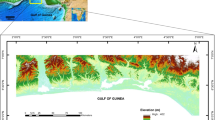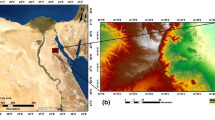Abstract
The Bahira Basin, located in Central Morocco, is a vast synclinal basin inserted between two Paleozoic basement. This basin is known for its large reserves of phosphate (Ganntour plateau), consequently it presents a regional economic interest. This study focuses on the use of aeromagnetic data to evaluate the thicknesses of sedimentary cover of the Bahira basin using enhancement methods, depth estimation techniques and 2D forward modeling. The enhancement methods were enabled to highlight the location and edge of the magnetic sources. The results show that most of the magnetic sources have hercynian orogeny trends. Combined 3D Euler Deconvolution and Source parameter imaging (SPI) methods indicate that depth to basement underlying the Cretaceous-Quaternary sedimentary cover exceed 7 km. The maximum depth values obtained from the various depth estimation methods correlated perfectly with each other. Generally, it was observed that the western part of the study area is characterized by thick sedimentation. The magnetic 2D forward modeling basement structure suggest the uplift of the Paleozoic basement at the south and north part of the Bahira basin. The results of this study can be used to better understand the basement structure of the Bahira basin for forward exploration interest.












Similar content being viewed by others
References
Al-Badani MA, Al-Wathaf YM (2018) Using the aeromagnetic data for mapping the basement depth and contact locations, at southern part of Tihamah region, western Yemen. Egypt J Pet 27:485–495. https://doi.org/10.1016/j.ejpe.2017.07.015
Arogundade AB, Hammed OS, Awoyemi MO et al (2020) Analysis of aeromagnetic anomalies of parts of Chad Basin, Nigeria, using high-resolution aeromagnetic data. Model Earth Syst Environ 6:1545–1556. https://doi.org/10.1007/s40808-020-00769-y
Ayoola AH, Osinowo O (2022) Analysis of airborne potential field data for hydrocarbon exploration in Southern Nigeria. Res Geophys Sci 10:100043. https://doi.org/10.1016/j.ringps.2022.100043
Beshr AM, Mohamed A, ElGalladi A, Gaber A, El-Baz F (2021) Structural characteristics of the Qena Bend of the egyptian Nile River, using remote-sensing and geophysics. Egypt J Remote Sens 24:999–9823. https://doi.org/10.1016/j.ejrs.2021.11.005
Bhattacharyya BK (1966) Continuous spectrum of the total magnetic field anomaly due to a rectangular prismatic body. Geophysics 31:97–121
Blakely RJ (1995) Potential theory in gravity and magnetic applications. Cambridge University Press, Cambridge
Ekwok SE, Achadu O-IM, Akpan AE et al (2022) Depth estimation of sedimentary sections and basement rocks in the Bornu Basin, Northeast Nigeria using high-resolution Airborne magnetic data. Minerals 12:285. https://doi.org/10.3390/min12030285
Selim ESI (2016) The integration of gravity, magnetic and seismic data in delineating the sedimentary basins of northern Sinai and deducing their structural controls. J Asian Earth Sci 115:345–367. https://doi.org/10.1016/j.jseaes.2015.10.012
Eshanibli AS, Osagie AU, Ismail NA, Ghanush HB (2021) Analysis of gravity and aeromagnetic data to determine structural trend and basement depth beneath the Ajdabiya Trough in northeastern Libya. SN Appl Sci 3:228. https://doi.org/10.1007/s42452-021-04263-7
Er-rouane S (1996) Mise en œuvre d’outils informatiques pour la modélisation du système aquifère de la Bahira (Maroc Occidental), Thèse, Université de Nancy I, p. 158
Evjen HM (1936) The place of the vertical gradient in gravitational interpretations. Geophysics 1:127–136
Fairhead JD, Mackenzie C, Green CM et al (2019) A new set of magnetic field derivatives for mapping mineral prospects a new set of magnetic field derivatives for mapping mineral prospects. 0586. https://doi.org/10.1071/ASEG2004ab042
Geosoft Oasis Montaj (2007) Mapping and application system Inc, Suite 500, Richmond St. West Toronto, ON, Canada N5SIV6
Hinze WJ, Von Frese RRB, Saad AH (2013) Gravity and magnetic exploration principles, practices, and applications. Cambridge University Press, New York
Huvelin P (1977) Etude géologique et gîtologique du massif hercynien des Jebilet (Maroc Occidental), 232 bis. Note et Mémoires du Service Géologique du Maroc, p 307
Ibraheem IM, Haggag M, Tezkan B (2019) Edge detectors as structural imaging tools using aeromagnetic data: a case study of Sohag area. Egypt Geosci. https://doi.org/10.3390/geosciences9050211
Ishola KS, Akerele PO, Folarin O et al (2020) Application of aeromagnetic data to map subsurface structural features in Ewekoro, Southwestern Nigeria. Model Earth Syst 6:2291–2302. https://doi.org/10.1007/s40808-020-00812-y
Jaffal M, Charbaoui A, Kchikach A et al (2022) Gravity study of the western Bahira Basin and the Gantour Phosphatic Plateau, central Morocco: interpretation and hydrogeological implications. J Afr Earth Sci 193:104581. https://doi.org/10.1016/j.jafrearsci.2022.104581
Karroum M, Khattach D, Himi M (2014) Earth Sciences Revue canadienne des sciences de la Terre In cooperation with the. https://doi.org/10.1139/cjes-2013-0130
Kebede H, Alemu A, Nedaw D, Fisseha S (2021) Heliyon depth estimates of anomalous subsurface sources using 2D / 3D modeling of potential fi eld data: implications for groundwater dynamics in the Ziway-Shala Lakes Basin, Central Main Ethiopian Rift. 7. https://doi.org/10.1016/j.heliyon.2021.e06843
Lee YW (1960) Statistical theory of communication. Wiley, New York, pp 1–75
Marason L, Klingele EE (1993) Advantage of using the vertical gradient of gravity for 3-D interpretation. Geophysics 58:349–355
Martins OE, Mosto OK, Ifeanyi OA (2021) Aeromagnetic interpretation of basement structure and architecture of the Dahomey Basin, Southwestern Nigeria. NRIAG J Astron Geophys 10:93–109. https://doi.org/10.1080/20909977.2021.1880817
Michard A (1976) Eléments de géologie marocaine. Note et mémoire du service géologique du Maroc 252, 399
Miller HG, Singh V (1994) Potential field tilt a new concept for location of potential sources. Appl Geophys 32:213–217
Milligan PR, Gunn PJ (1997) Enhancement and presentation of Airborne Geophysical Data. J Australian Geol Geophys 17:63–75
Nait Bba A, Boujamaoui M, Amiri A, Hejja Y et al (2019) Structural modeling of the hidden parts of a paleozoic belt: insights from gravity and aeromagnetic data (Tadla Basin and Phosphates Plateau, Morocco). J African Earth Sci 151:506–522. https://doi.org/10.1016/j.jafrearsci.2018.09.007
Reid AB, Allsop JM, Granser H, Millett AJ, Somerton IW (1990) Magnetic interpretation in three dimensions using Euler deconvolution. Geophysics 55:80–91
Reid AB, Ebbing J, Webb SJ (2013) Avoidable Euler errors – the use and abuse of Euler deconvolution applied to potential fields. Geophys Prospect 62:1162–1168. https://doi.org/10.1111/1365-2478.12119
Saada SA (2016) Edge detection and depth estimation of Galala El BahariyaPlateau, Eastern Desert-Egypt, from aeromagnetic data. Geomech Geophys Geo-energ Geo-resour 2:25–41. https://doi.org/10.1007/s40948-015-0019-6
Saleh A, Abdelmoneim M, Abdelrady M, Deep M, Al (2018) Subsurface structural features of the basement complex and mineralization zone investigation in the Barramiya area, Eastern Desert of Egypt, using magnetic and gravity data analysis. Arab J Geosci 11:676. https://doi.org/10.1007/s12517-018-3983-7
Salem A, Williams S, Fairhead D et al (2008) Interpretation of magnetic data using tilt-angle derivatives. Geophysics. doi 10(1190/1):2799992
Spector A, Grant F (1970) Statistical models for interpreting aeromagnetic data. Geophysics 35:293–302
Talwani M, Heirtzler JR (1964) Computation of magnetic anomalies caused by two-dimensional structures of arbitrary shape. In: Parks GA (ed) Computers in the Mineral Industries. Stanford University Press, Stanford, pp 464–480
Thompson DT (1982) EULDPH: a new technique for making computer assisted depth estimates from magnetic data. Geophysics 47:31–37
Thurston JB, Smith RS (1997) Automatic conversion of magnetic data to depth, dip, and susceptibility contrast using the SPI (TM) method. Geophysics 62:807–813
Verduzco BJD, Fairhead CM, Green, MacKenzie C (2004) New insights into magnetic derivatives for structural mapping. Lead Edge 23:116–119
Author information
Authors and Affiliations
Corresponding author
Ethics declarations
Conflict of interest
The authors have no conflicts of interest to declare.
Additional information
Publisher’s Note
Springer Nature remains neutral with regard to jurisdictional claims in published maps and institutional affiliations.
Rights and permissions
Springer Nature or its licensor (e.g. a society or other partner) holds exclusive rights to this article under a publishing agreement with the author(s) or other rightsholder(s); author self-archiving of the accepted manuscript version of this article is solely governed by the terms of such publishing agreement and applicable law.
About this article
Cite this article
Lghoul, M., Elgoumi, N. & Guernouch, M. Contribution of the enhancement methods and 2D modeling to the evaluation of sedimentary cover thicknesses of the Bahira basin (Morocco) using aeromagnetic data. Model. Earth Syst. Environ. 9, 4335–4347 (2023). https://doi.org/10.1007/s40808-023-01760-z
Received:
Accepted:
Published:
Issue Date:
DOI: https://doi.org/10.1007/s40808-023-01760-z




